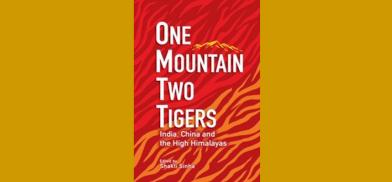Can India and China co-exist?
One mountain Two Tigers - India, China and the High Himalayas is edited by Shakti Sinha and is published by Pentagon Press. Pages: 201. Price: Rs. 795

Considering the fact that Indians are very good at creating history, but not at recording it, or teaching and learning from it, this is a timely book, in which fourteen writers bring out some fascinating facets of history, trade and cultural links across the Himalayas. Thereby, this book – One Mountain Two Tigers - India, China and the High Himalayas - enhances our insight on aspects of the Indo–China border dispute, which unfortunately for India, was managed on the basis of not to do anything to raise the level of conflict and also not to annoy the Chinese and allow them to bully us.
While on the tough terrain, Indian Army taught its Chinese counterpart a hard lesson in Sikkim, in 1967, on the table India often lost out not only for being soft in approach but also because much of important history data was not available and that which was available, was not used. The Chinese Communist Party specializes in pushing perceived history. However, on August 29, India and its army made history by not just being proactive but hitting the Chinese hard with the Tibetan troops of India’s special forces.
Glimpses of the chapters will be relevant to give an idea about the book’s value.
Subhask Kak (When Xinjiang Was a Part of the Indic World) brings out how the region now known as Xinjiang, was Uttarakuru for the post-Vedic Indians, with specific references to its location north-west of Kailash-Mansarovar. The people spoke different Indo-Aryan languages include Khotanese, Prakrit, and others, used Indian scripts like Brahmi and Sanskrit were even present. Inscriptions in Sanskrit has been found even far to the east, in Chinese provinces. It was with the collapse of the Buddhist kingdoms of that region at the hands of Muslim Uyghurs from Mongolia in the 11th century that the strong Indic elements got suppressed.
Punchok Stobdan (At India-China Relations: Ladakhi and Dogra Claims in China), who is known for reminding that all of China bordering India is Tibet, narrates the political rise of Ladakh, particularly under Singge Namgyal, ran into an expansionist Tibet under the Fifth Dalai Lama, and sought the help of the Mughal Emperor Aurangzeb. Ultimately, the Bhutanese and Ladakhis joined forces to oppose Tibet, with religious schism – the Gelug dominated Tibet, while Ladakh and Bhutan followed the Drukpa tradition – playing an important role.
The establishment of the People’s Republic of China and its subsequent occupation of Tibet and Xinjiang disrupted the long-standing trading relations involving Xinjiang, Ladakh, and Tibet, with Leh as its hub. Prof. K Warikoo (Trans-Himalayan Trade of Kashmir and Ladakh with Tibet and Xinjiang, 1846-1947) reminds us that though today is seen as geographically distant and physically remote, these three regions traded with each other rather intensively till very recently. Leh was a veritable metropolitan city in terms of its diversity of the population that met and traded goods from distant lands.
Alok Bansal (India China Border Dispute in Ladakh) goes into the details of the India-Tibet boundary, now more contested as ever since China has chosen to raise new disputes. He takes us through traditional practices; past treaties and British fears about the Russian advance towards Tibet that made them take different positions at different times. Independent India did inherit complicated and often un-demarcated boundaries and shifting Chinese positions has not helped matters.
Ajay Singh (The Shadows of 1962) traces the origins of the India-China dispute from the early 1950s, and with each step along the way, the gap only widened. The Jawaharlal Nehru-Zhou Enlai’s dialogue did not achieve the understanding expected. Ultimately, India realised that it would have to be more aggressive about its defence of territory but the army was woefully under-equipped and under-clad. Nehru’s forward policy was militarily indefensible. Worse, it gave the Chinese the pretext to launch their offensive in October 1962.
Sriparna Pathak (1962 and beyond) looks at the domestic and international factors, largely the former, that led Mao Zedong and his successors create a convenient ‘enemy’ against who armed action could be used as a diversionary tactic. India happened to be the victim. Mao’s disastrous economic policies like the Great Leap Forward led to serious man-made famines in which millions starved to death. This weakened Mao’s position to the extent that he feared being ousted by the group of ‘right deviationists’ led by Lio Shaoqi and Deng Xiaoping. In different ways this led to the war on India in 1962; similarly the chaos of the Cultural Revolution can be linked to the 1967 actions at Nathu La.
Lt Gen (Dr) Rakesh Sharma (retd) (Geo-Strategic Construct of Eastern Ladakh) combines his experiential knowledge of this region with serious analytic vigour to explain the geo-strategic location and features that must be taken into account. Based on this, he then moves to suggest how India should move tactically and strategically to strengthen its capabilities.
Lt Gen Vinod Bhatia (retd) (Post-Galwan: Deter China’s Aggressive Behaviour) argues for learning the right lessons from why the present conflict arose, particularly as the present approach is qualitatively different from earlier incursions at Depsang (2013), Chumar (2014) or Doklam (2017): clearly the Chinese are here to stay. China’s use of its ‘Three Warfare’ strategy has been resolutely opposed by India, but this is only a holding exercise. Ultimately, the issues would have to be settled politically. To ensure a favourable outcome, India must properly operationalise the Mountain Strike Corps; develop capabilities understanding the concept of comprehensive national power and reach out to countries in South-East Asia.
Monish Tourangam (The India-China Quandary: Looking Beyond the Bilateral) takes a larger perspective and traces the bilateral relationship since 1949 and the role of countries like Pakistan and the USA into the state of India – China relations. The apprehension of a two-front war, India’s role in the CIA’s activities in Tibet, the Indian nuclear tests, and the implications of China’s economic rise and its BRI strategy are relevant factors whose role and importance must be understood. The increasing power asymmetry would push India–US closer inevitably.
In a way it is not surprising that the ‘Wuhan spirit’ and ‘Chennai Connect’ would unravel so quickly, as Prachi Aggarwal (Wuhan Spirit and Modi-Xi Dynamics) explains because the underlying lack of common understanding of even the contested boundary. Nevertheless, the Galwan breakdown was preceded by intense discussion between two leaders, who both are very nationalistic, have come up after overcoming obstacles and have demonstrated decisive leadership. Prime Minister Narendra Modi had resisted trying to take sides in the US-China dispute and was even praised by the Chinese media for this. However, the growing economic and power asymmetry, China’s desire to benchmark itself against the US and its conviction that Asia can have only one superpower – hence the title of the book – made the dispute inevitable.
Hema Narang (Soft Power Conundrum and China-India Relations) takes up the COVID pandemic to show how China’s reputation has diminished and India’s has improved. This difference could be largely explained by the first being state-centric, top-down whilst the other is autonomous and culture-based. China makes extensive use of its economic might to influence external actors, while India has been unable to optimise the attractiveness of its appeal.
Shekhar Sinha (Indo-Pacific: Anxiety or Strategy?) traces the inevitable hubris of being the sole superpower – attempts to impose liberal democracies, military over-stretch, and a fundamental misread of China. The result was that as the US position weakened, China gained economically. China has in fact, moved in to fill the vacuum created by US withdrawal, using military coercion and economic power to project its power. He concludes that the Indo-Pacific, identified with the Quad, and ultimately Quad+, the grouping of democracies would be in a position to confront this non-peaceful rise of China.
Sana Hashmi (Taiwan in the India-China Dynamics) makes a powerful case for India to engage with Taiwan more intensely. However, any thoughts of doing so in order to play the ‘Taiwan card’ would be limiting and not in India’s interest. Taiwan has emerged as an economically strong and robust democracy and this should attract India’s interest. India should not let the shadow of Beijing constrain India’s abilities to engage with Taiwan more broadly, with economics at its core.
Shakti Sinha (China: Anxiety and Aggression) identifies various economic, social, and political factors that make the CCP leadership anxious about the future. These include problems with the needed transformation from an investment-based, export-driven economy to a services-based, consumption-driven one. The falling GDP growth rates reduced productivity and the worsening external climate pose huge challenges. This is reflected socially in rising inequality, concerns about corruption, and issues about CCP’s credibility and ultimately legitimacy. The Belt and Road Initiative (BRI) should be seen as China’s efforts to export its surplus capacity with costs to be paid by developing countries and stepped up military coercion on its borders.
Taking advantage of the pandemic, China stepped up its military consolidation wherever possible for achieving its ultimate aim of global domination. At least 125 countries have issues with China for its role and responsibility in the origin of the pandemic. The book is useful as a reference piece.
(The author, a strategic analyst and former spokesperson, Defence Ministry and Indian Army, can be contacted at wordsword02@gmail.com. The views expressed are personal)










Post a Comment